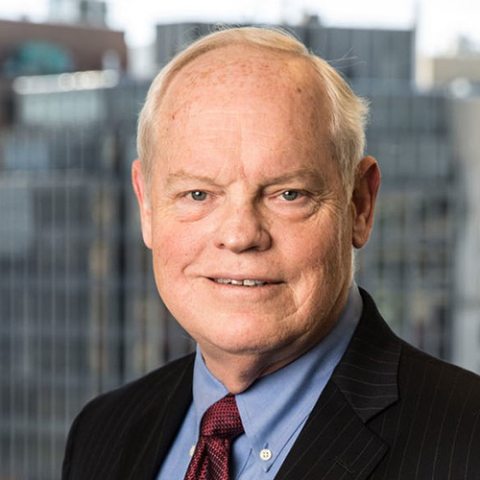Politics is the competition of interests and the competition of ideas. The advantage lies with interests that are organized and entrenched (teachers, farmers) and with ideas that mobilize effective interest groups (green energy, homeownership). Ideas that lack an organized constituency usually get lost in the shuffle, even when they are very good ideas.
But sometimes a simple idea prevails over politics as usual, with spectacular results. That was the lesson of two Washington events earlier this year -- one concerning a historical success, the other an opportunity before us today.
In January, the Library of Congress hosted a celebration of the career of Clay T. (Thomas) Whitehead (1938-2008), a young White House staffer in the Nixon administration. The occasion was the Library's accession of Whitehead's papers. This event, involving a little-known government figure from 40 years ago, attracted an impressive array of public officials, journalists, business executives, and policy intellectuals. Many brought their families. A panel of colleagues and academic observers told the story of a man of personal modesty and brilliant insight whose simple idea baffled the Washington establishment and revolutionized the communications industry.
When Tom Whitehead arrived in Washington in 1969, long-distance communications were government-protected monopolies -- the Bell System (AT&T) for telephones, the three broadcasting networks (ABC, CBS, and NBC) for television and radio. Telephone service, broadcast TV and radio, and the military all depended on Ma Bell's terrestrial transmission system, which was well engineered but also expensive and inflexible. Bell Labs had made important technical inventions, but the only new products anyone knew about were color television and color telephones. New technologies were cropping up -- cable television, mobile cellular telephones, microwave transmission, satellites -- but were being treated as appendages to the old systems. Cable television was long extension cords for delivering broadcast TV to rural communities with poor rooftop reception. Communications satellites were a government monopoly, COMSAT, operated in partnership with Ma Bell.
All of this was assumed to be the natural order of things, and the Federal Communications Commission (FCC) protected that order zealously. It prohibited cable-television operators from offering programs of their own, lest they siphon viewers from the networks. For the newfangled cellular telephones, it reserved licenses for AT&T alone.
Whitehead saw things differently. He realized that the new technologies could supplant, rather than supplement, the status quo. He could not foresee exactly how this would happen, but he knew that the key was communications satellites. At the time, these were small, low-power devices, capable of only limited channels of communication with elaborate ground stations. But they were new and few and government-spec. With experience, costs would fall and quality would improve; with commerce and competition, new uses would be discovered. Constellations of "radio towers in the sky" might provide a profusion of independent channels of voice, video, and data communication at vastly lower cost and in vastly greater variety than through the existing nest of land wires. All that was needed was to free satellite technology from the command-and-control mindset that suffused the official task-force reports and regulatory blueprints then in circulation.
Whitehead's simple idea was "Open Skies": Any firm with the technical and financial wherewithal should be permitted to launch and operate its own communications satellite. The proposition was entirely permissive -- it involved no central planning; no pilot projects; no restrictions, taxes, subsidies, or guarantees; no requirements that anyone do anything. Whitehead thought someone might give it a try. He figured there was room for 15 to 20 domestic satellites. That might lead, he said, to increased "flexibility" and "innovation," but he didn't promise any particular benefits and emphasized the difficulties and uncertainties.
Open Skies was a strange and astonishing concept when it was first proposed in 1970. Everyone of importance opposed it -- AT&T, the broadcast networks, the FCC, the Pentagon, influential members of Congress, and some of Whitehead's senior White House colleagues. Some lobbied vociferously against it; others thought it (and its author) merely daft. But, precisely because the idea was permissive and hypothetical, opponents had a hard time writing up talking points against it. It wasn't illegal (international satellite communications were then a government monopoly, but the statute in question was silent on domestic satellites). The economies of scale (costs of service decline as a single network expands to serve additional customers) that justified the Bell System monopoly seemed not to apply to satellites, so entry and price controls would be unnecessary. If a firm mounted a satellite that failed technically or commercially, the financial losses would be all its own.
Whitehead was a laconic engineer and systems analyst with no experience in politics. But his mastery of the underlying technology meant that he could not be buffaloed by lobbyists, and his dry, just-the-merits advocacy began to win converts. He skillfully encouraged opponents to consider the upside risks, not just the downside ones. The Nixon White House, locked in daily combat with the network news shows, was excited at the prospect of diverse local TV stations independent of the evil empire of ABC, CBS, and NBC. For their part, the networks were excited at the prospect of distributing programs with their own satellites, freed of their costly dependence on Ma Bell. As others fell into line, AT&T decided to settle for a seat at the table. The FCC adopted Open Skies in all essentials in 1972; by then, the only strong opponent was its own regulatory staff.
Open Skies launched a commercial space race. By the early 1980s, several firms, such as RCA and Hughes (as well as Bell), were operating satellites -- leasing transmission channels to the broadcast networks and also to cable upstarts such as HBO, Turner, and CNN. Cable TV had sealed its arrival as an independent force by establishing its own public-service station, C-SPAN. AT&T was losing its market power even before the 1984 antitrust break-up of its landline-telecommunications monopoly.
Today a canopy of several hundred satellites operated by dozens of firms beams hundreds of television and radio channels directly to millions of homes, offices, and automobiles. In tandem with fiber optics and cellular and other terrestrial networks, satellites relay telephone, video, and Internet communications around the globe. Commercial satellites supply those connections directly in remote locations, and government satellites are now the content providers for GPS navigation services and real-time weather surveillance. As much as I love my mailman, a USPS satellite service could not have done all this.
Competition and innovation have produced low costs, high quality, endless variety, and a sheer ubiquity that would have been inconceivable in 1970 -- and a degree of democratic interconnectedness that is surely the most important development of modern life.
Whitehead was responsible for several other policy innovations during his White House years, and for several engineering and commercial innovations in a subsequent business career. (Setting up shop in tiny Luxembourg and making use of its national allocation of orbital slots, he founded SES Astra, Europe's first private satellite operator, which unilaterally dismantled Europe's national media monopolies.) But, in retrospect, Open Skies was the grand policy stroke: It was certainly a necessary condition to the communications revolution, and was probably a sufficient condition as well. At the Library of Congress symposium, the eminent economist Thomas Hazlett, a man who chooses his words carefully, concluded that Whitehead had made "one of the most brilliant contributions to communications markets since Morse, Bell, or Marconi."
The second Washington event was a striking echo of the first. At a Hudson Institute workshop in February, former FCC commissioner Harold Furchtgott-Roth (now a Hudson Institute fellow) presented a paper on today's hot topic in communications -- the shortage of radio spectrum available for smartphones, tablets, and other devices that rely on wireless broadband. The problem has generated task-force reports, agency blueprints, industry white papers, congressional hearings, and presidential proclamations. Everyone agrees that the shortage, routinely described as a crisis, is seriously retarding a critical sector of the economy. But all of the proposed solutions are highly complex -- and highly partial, in both senses of the term: Each addresses only part of the problem, and does so in ways that serve the proponent's immediate political or economic interests.
Into this melee, Furchtgott-Roth tossed an idea as simple and astonishing as Open Skies had been in 1970. Understanding its power requires a bit of briefing -- for although almost everyone now uses smartphones, laptops, tablets, and similar devices, few of us know much about the invisible infrastructure that supports them.
Radio waves are the medium for all wireless communication (on the electromagnetic-frequency spectrum, they occupy the portion with longer wavelengths and lower frequencies than those of visible-light waves). Radio transmission is regulated by the FCC through licenses that specify the permitted frequency, geographic area, time of day, and transmission power and equipment. And spectrum licenses may be used only for FCC-designated purposes -- such as television and radio broadcasting, mobile-telephone and smartphone service, various satellite links (satellite to ground, ground to satellite, satellite to satellite), and a host of narrower purposes such as police radio, maritime navigation, and meteorological satellite communications. If you want to offer a communications service, but the FCC has already allocated all of the spectrum it has "zoned" for that service, you are probably out of luck. Spectrum licenses may be bought and sold, but only after case-by-case FCC review and approval -- and the restrictions on a seller's spectrum continue to apply to the buyer, so that the license of an AM radio station is available, at any price, only for AM broadcasting by someone else.
Different radio frequencies are better suited to different applications, depending on such variables as distance, transmission capacity, and "propagation properties" (e.g., whether frequencies penetrate walls). The FCC's zoning scheme takes account of these technical considerations but is also based on estimates of market demand for various uses -- and that is the source of the current problem. The fantastic growth of smartphones, tablets, and laptop computers -- there were 326 million U.S. wireless subscriber connections at the end of 2012 -- and the increasingly routine use of videostreaming, personal navigation, cloud storage, and other spectrum-intensive applications have far outstripped the FCC's spectrum allocation for wireless broadband. At the same time, the growth of cable and satellite television, which now reach the vast majority of households, has left a great deal of spectrum for broadcast television underused or dormant. (The TV-broadcast zone, first established in the early 1950s, still maintains generous allocations for local UHF, or ultra-high-frequency, television stations; UHF required special, funny-looking antennas -- senior citizens may remember them.) The spectrum designated for broadcast TV is ideal for wireless broadband, yet much of it is lying fallow.
The shortage of wireless broadband spectrum is certainly a severe problem. It is needlessly raising the costs and retarding the speed and quality of personal communications (Onion headline: "Internet Collapses Under Sheer Weight of Baby Pictures"). Wireless providers such as Verizon and AT&T have been obliged to raise prices and reduce speeds selectively for heavy users of video and data applications, leading to charges of "discrimination" that the FCC has taken seriously. It is also fostering wasteful commercial strategies, such as AT&T's ill-fated attempt to acquire T-Mobile, which was really a desperate attempt to acquire spectrum. At the same time, the shortage is retarding long-distance learning and medicine, air- and highway-traffic control, and innumerable business applications, all with immense potential for social betterment. Many on-the-horizon applications, such as continuous remote monitoring of medical patients, self-driving cars, and greatly strengthened cybersecurity for personal and commercial information, simply will not get beyond the pilot stage without large additions of wireless broadband spectrum.
Serious though the shortage of wireless broadband spectrum is, it points to a problem that is larger still. A central administrative agency such as the FCC cannot possibly know the relative values, among multifarious and ever-changing uses, of a resource as versatile and pervasive as radio waves. The Commission has erred many times in the past. In the 1960s and 1970s, it delayed the introduction of mobile-cellular-telephone service by at least a decade. Even when its judgments are approximately correct for the time being, it lacks the flexibility to take account of varying local circumstances. (Spectrum zones are nationwide, so a given frequency generally cannot, for example, be used both for monitoring financial exchanges in Manhattan and for mountain-rescue radio in Durango.) And the FCC's errors are not random: It is naturally attentive to incumbent firms that know the agency ropes and support its budget, and less so to newbies with unfamiliar ideas that could disrupt the settled plans of its licensees and its staff.
The system was the brainchild of Secretary of Commerce Herbert Hoover in the 1920s, and it squelched the development, then under way, of property rights in radio spectrum, including legal rules to settle conflicts among different uses. It was a mistake, but an understandable mistake. Radio was then a strange new phenomenon, useful mainly for public purposes such as broadcasting, navigation, and military communications; it was an invisible frontier that, it seemed, the government should develop for the public good. At the time, moreover, the known uses for radio were few in number, so designating frequencies for particular uses was a simple matter. But radio has long since become well developed and familiar. Almost everyone uses it several times every day, mostly for purposes that are private and personal (searching, networking, scheduling, sharing stuff with family, friends, and colleagues). And 80 years of experience and discovery have generated innumerable new uses of more and more spectrum (at progressively higher frequencies), along with methods for sharing individual frequencies for multiple purposes and combining different frequencies for the same purposes. The effort to assign particular frequencies to particular uses has become antediluvian and increasingly retrograde.
Careful students of spectrum management, from all points on the political spectrum, long ago concluded that it could and should be a straightforward matter of private property, subject to the same laws -- contract, nuisance, antitrust -- that govern land, real estate, and other tangible assets. The military, the police, and other government agencies would own and employ radio spectrum for public purposes and buy and sell increments as necessary, just as they do other resources. The FCC would operate the national equivalent of a county land-title office, where buyers and sellers could assure themselves of good title and register rights and obligations affecting other owners. The entire process would be online and searchable -- an excellent use of spectrum.
The question is how to get from here to there, or at least far enough along to resolve the current crisis. This is a matter not of partisan gridlock, but rather of insiders versus the rest of us. The current system has given rise to many political and economic interests that will oppose reforms that threaten them. An example is the perennial idea of charging license holders a substantial annual fee to discourage hoarding of unused or underused spectrum -- an idea the license holders reliably quash whenever it is introduced. The FCC, to its credit, has begun in recent years to liberalize its zoning restrictions and procedures for reviewing spectrum transactions, and has taken steps to reallocate spectrum to wireless broadband from other uses. But the television broadcasters have obstructed many of these moves, fearing that they presage a concerted raid on their treasure trove of spectrum for reassignment to the new wireless applications.
The most important reform idea is the spectrum auction. The Commission has conducted scores of auctions since 1994, raising about $60 billion. While a big improvement over the FCC's traditional administrative hearings for dispensing available spectrum, the auctions operate within the established spectrum zones, which are the heart of the misallocation problem. And they are absurdly over-centralized, with the FCC acting as exclusive agent for both bidders and sellers and as zoning commissioner to boot. As a result, the auctions are extraordinarily desultory -- involving hundreds of pages of rules, arcane restrictions on who may bid, and lengthy delays, and yet involving only limited spectrum bands. The Commission is now planning auctions to reallocate some (almost certainly not enough) additional spectrum to wireless broadband. It is operating under a statutory deadline of 2022 -- and, with initial auctions still years away, will probably miss even that. Or, more likely, the auction process will simply collapse as it falls farther and farther behind the growing spectrum shortage. The FCC process has completely lost touch with the economic and technological dynamics of modern communications.
Which brings us to Harold Furchtgott-Roth's breathtakingly simple idea. He calls it "Open Spectrum": The FCC would allow license holders to use their spectrum for any valid purpose, and permit spectrum to be bought and sold with only minimal restrictions. The Commission could do this immediately. (While spectrum auctions require authorization from Congress, the spectrum zones are the Commission's own handiwork and can be liberalized as it sees fit, as it has done in limited cases in recent years.) It would issue a rule, requiring a few pages of text and a few months to adopt, that removed the use restrictions in practically all spectrum licenses. From that moment on -- say, as of January 1, 2014 -- there would be no spectrum shortages. Broadcast-television licensees could sell spectrum to cellular-service providers, or not, or some spectrum but not all, depending on which application appeared more valuable. So could licensees in many other areas of misallocated spectrum that are not in the headlines and that the FCC doesn't even know about. Frequencies could be used for different applications in different locales and at different times of day. Or they could be used for different applications in the same place from minute to minute, relying on technologies that deploy spectrum among different uses in real time according to usage patterns. Or different frequencies could be used in tandem for purposes now forbidden because some of the frequencies are in the wrong zone. The FCC would continue with its auctions of unallocated spectrum, but without restrictions on use.
Open Spectrum, like Open Skies, is entirely permissive. It doesn't require anyone to do anything; it leaves it to license holders to bear the expenses and take the consequences, profit or loss, of whatever they decide to do. It simply opens up new opportunities. But, unlike Open Skies, Open Spectrum is not entirely hypothetical in its prospective economic benefits. From the prices paid in recent FCC auctions and private spectrum transactions, from the returns on recent investments in wireless services, and from empirical data on currently unused and underused spectrum, we can get a glimpse of the benefits of relieving the wireless-broadband shortage. Academic and industry studies using these data find short-term economic benefits of many hundreds of billions of dollars. There are large ranges of uncertainty in these estimates, and probably some puffery in the industry estimates. But if one looks at expenditures and economic value (to both consumers and producers) in the initial stages of wireless growth, and at the many high-value, technically feasible applications now under development, the estimates are more than plausible. They certainly understate the benefits of Open Spectrum in important respects -- they do not take account of the value of improved spectrum use outside wireless broadband, nor that of continuous improvements that the current system would insensibly obstruct.
Most of all, the economic gains of Open Spectrum would begin to be realized almost immediately, rather than years in the future as under every alternative proposal. They would be large enough to show up in aggregate measures of national economic performance. And, because they would arise from the uncorking of new opportunities, they would not be subject to the zero-sum political wrangling that dooms so many economic-policy reforms (more on this anon).
The idea of Open Spectrum is not entirely new with Furchtgott-Roth; he has drawn on earlier research, especially that of Thomas Hazlett and of the FCC's policy-planning staff. But it is the most accessible and far-reaching version to date, and sure to generate controversy. Three objections will be made, all of them flimsy. Flimsy arguments have been known to prevail in political debate, but perhaps they will not prevail here. The permissiveness of Open Spectrum at once exposes the weakness of the objections and provides the vigorish for turning reform opponents into reform advocates.
The first objection is that license holders, freed of the FCC's usage zones, will employ spectrum in ways that create radio interference with other licensees (those in adjacent spectrum bands or geographic areas). But interference is legally actionable and can be resolved by direct negotiation among users of adjacent spectrum: This happens routinely even with the current zoning scheme. The FCC's own approach to interference is horribly wasteful, involving the preservation of large amounts of "buffer" -- i.e., unused -- spectrum between active bands. That approach led to the Commission's 2012 decision, based on interference objections from GPS service providers, to revoke LightSquared's permission to establish a new wireless broadband network -- after it had already invested $4 billion in the enterprise. It was a policy debacle of the first order: The social value of the new broadband network would have been far greater, probably by orders of magnitude, than the costs of resolving any GPS interference problems. Under Open Spectrum, spectrum that is now warehoused as buffer would be deployed, and border conflicts would be left to straightforward commercial resolution rather than lobbyist-infested political resolution. Spectrum-sharing technology plus the law of contract would move much more spectrum into productive use -- and reveal how and where, in fact, spectrum could be used most productively.
The second objection is that exclusive spectrum rights should not be liberalized but rather abolished -- in favor of unlicensed, open-access spectrum, or "common spectrum." In this vision, the unlicensed spectrum now used in such applications as Wi-Fi and Bluetooth would be expanded to replace the licensed spectrum used in cellular wireless networks and other proprietary systems. Unlicensed spectrum is indeed useful in low-power, limited-range environments such as homes, offices, and coffee shops, where it connects wireless devices (e.g., baby monitors, TV remote controls) to larger networks or is entirely local. It could not, however, be scaled up to longer-range, higher-power, point-to-point communications among large numbers of users without central regulation of impossible complexity. As the FCC has increased unlicensed spectrum, it has had to increase its technical controls over the permitted uses of that spectrum, and also its restrictions on licensed spectrum that might interfere with the unlicensed uses. If the trend continues, the result will not be a free and happy spectrum commons but, to the contrary, greater regimentation and more frequent shortages. The allure of unlicensed spectrum is strong among some academics and business firms, but that allure will fade as the possibilities for Open Spectrum sink in. Spectrum-sharing technologies can increase the range and utility of "common" unlicensed spectrum -- but they can do the same for "owned" licensed spectrum. They have already done so in such cases as wireless connections to Kindle book readers and GM's OnStar navigation system, both of which piggyback on licensed broadband by private agreement; once spectrum licenses are opened up to multiple uses, licensees will deploy many more such applications.
The third objection is that Open Spectrum would permit license holders to profit from spectrum that belongs to the public, and thereby abscond with the government revenues that the FCC's spectrum auctions could raise. The first part of this argument is a fallacy: Licensees have always profited from whatever economic value they could produce with spectrum (from their own use or sale to others), and their increased returns from Open Spectrum would simply reflect the increased value to consumers from correcting current spectrum misallocations (consumers themselves would realize even greater returns). The second part is backwards: Open Spectrum would increase government revenues, probably by a great deal. Tax revenues from capital gains on spectrum transactions, sales taxes on goods and services that better-used spectrum made possible, and taxes on added personal and corporate income would far exceed the estimated $15 billion in revenues from the FCC's planned auctions. The tax revenues, moreover, would come in years sooner, and would continue as Open Spectrum led to continuous improvements in spectrum use and to development of new goods and services. The demands of government revenue collection often conflict with private-sector productivity, but there is no such conflict in the choice between spectrum auctions and Open Spectrum, because the gains from Open Spectrum would be orders of magnitude greater.
It remains the case that those who currently hold spectrum licenses would be among the most important and immediate beneficiaries of Open Spectrum. (The others would be producers who need spectrum now but lack the necessary licenses, and consumers who would receive new, better, and lower-cost services -- that would be almost all of us.) And therein lies the idea's political genius. For it is current licensees who have been most threatened by previous proposals to improve spectrum use through annual spectrum fees, claw-backs of underused spectrum, and reduced spectrum buffers. The licensees have proven to be highly effective in delaying or defeating those proposals and in influencing spectrum auctions to their advantage. But Open Spectrum, by greatly increasing the economic value of currently licensed spectrum, turns the incentives around -- transforming licensees into an interest group for what is also in the public interest. As in the case of Open Skies, its permissiveness turns the attentions of those most directly involved from political rent-seeking to economic opportunities. As in the case of Open Skies, congressional leaders who were initially alarmed by the initiative would be assured by powerful constituents that the Commission was on the right track.
Open Spectrum exemplifies Leonardo's adage that "simplicity is the ultimate sophistication" -- which, appropriately, was also Steve Jobs's slogan for the first Apple computers. It holds the promise of correcting in a stroke a terrible waste of one of nature's most valuable resources, generating profound economic benefits and spurring a new round of technological innovation. All it requires is a latter-day Tom Whitehead with the vision and gumption to make the idea his own, master the inside politics, and lead the way so that others might follow. Ideas of such simplicity and power come around infrequently; when they do, they really ought to be seized.












